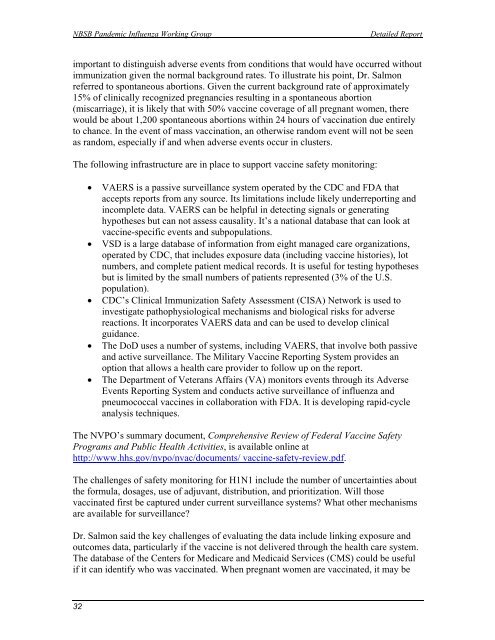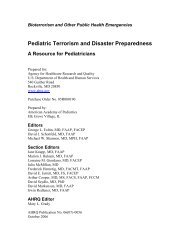H1N1 COUNTERMEASURES STRATEGY AND ... - PHE Home
H1N1 COUNTERMEASURES STRATEGY AND ... - PHE Home
H1N1 COUNTERMEASURES STRATEGY AND ... - PHE Home
You also want an ePaper? Increase the reach of your titles
YUMPU automatically turns print PDFs into web optimized ePapers that Google loves.
NBSB Pandemic Influenza Working Group<br />
Detailed Report<br />
important to distinguish adverse events from conditions that would have occurred without<br />
immunization given the normal background rates. To illustrate his point, Dr. Salmon<br />
referred to spontaneous abortions. Given the current background rate of approximately<br />
15% of clinically recognized pregnancies resulting in a spontaneous abortion<br />
(miscarriage), it is likely that with 50% vaccine coverage of all pregnant women, there<br />
would be about 1,200 spontaneous abortions within 24 hours of vaccination due entirely<br />
to chance. In the event of mass vaccination, an otherwise random event will not be seen<br />
as random, especially if and when adverse events occur in clusters.<br />
The following infrastructure are in place to support vaccine safety monitoring:<br />
<br />
<br />
<br />
<br />
<br />
VAERS is a passive surveillance system operated by the CDC and FDA that<br />
accepts reports from any source. Its limitations include likely underreporting and<br />
incomplete data. VAERS can be helpful in detecting signals or generating<br />
hypotheses but can not assess causality. It’s a national database that can look at<br />
vaccine-specific events and subpopulations.<br />
VSD is a large database of information from eight managed care organizations,<br />
operated by CDC, that includes exposure data (including vaccine histories), lot<br />
numbers, and complete patient medical records. It is useful for testing hypotheses<br />
but is limited by the small numbers of patients represented (3% of the U.S.<br />
population).<br />
CDC’s Clinical Immunization Safety Assessment (CISA) Network is used to<br />
investigate pathophysiological mechanisms and biological risks for adverse<br />
reactions. It incorporates VAERS data and can be used to develop clinical<br />
guidance.<br />
The DoD uses a number of systems, including VAERS, that involve both passive<br />
and active surveillance. The Military Vaccine Reporting System provides an<br />
option that allows a health care provider to follow up on the report.<br />
The Department of Veterans Affairs (VA) monitors events through its Adverse<br />
Events Reporting System and conducts active surveillance of influenza and<br />
pneumococcal vaccines in collaboration with FDA. It is developing rapid-cycle<br />
analysis techniques.<br />
The NVPO’s summary document, Comprehensive Review of Federal Vaccine Safety<br />
Programs and Public Health Activities, is available online at<br />
http://www.hhs.gov/nvpo/nvac/documents/ vaccine-safety-review.pdf.<br />
The challenges of safety monitoring for <strong>H1N1</strong> include the number of uncertainties about<br />
the formula, dosages, use of adjuvant, distribution, and prioritization. Will those<br />
vaccinated first be captured under current surveillance systems? What other mechanisms<br />
are available for surveillance?<br />
Dr. Salmon said the key challenges of evaluating the data include linking exposure and<br />
outcomes data, particularly if the vaccine is not delivered through the health care system.<br />
The database of the Centers for Medicare and Medicaid Services (CMS) could be useful<br />
if it can identify who was vaccinated. When pregnant women are vaccinated, it may be<br />
32
















